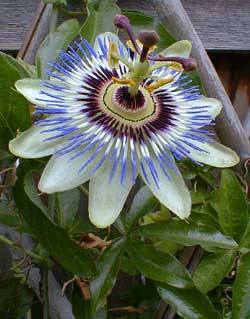 Blue Crown Passion Flower,
Blue Crown Passion Flower,
with a few notes on other passion vines
I. We Plant Passiflora caerulea
"But there is a passion-flower in my vase
Standing above a close-cleared space
In the midst of a jumble of papers and books.
The passion-flower holds my eyes,
And the light-under-light of its blue and purple dyes
Is a hot surprise."
-Amy Lowell,
1874‚1925
Puget Sound weather isn't thought to be ideal for the climbing vine Passiflora caerulea if one wishes to experience its fully evergreen potential, but it will adapt as a deciduous or semi-evergreen vine, & is on that level very adaptable to our climate. I only installed it in March 2002, & wasn't certain until the middle of its first winter if it was going to die back a great deal or only a little. I knew it was certainly not going to be fully evergreen as it would be in more southerly climates, & I had no problems with the possibility that it might've proven to be deciduous here. But there was additionally some risk of it being killed altogether by the dampness of our winters. As it is planted against a fence behind which is a vertical cliff wall, the drainage couldn't be any sharper, so I was pretty sure it was not at risk of being too wet for winter. 1874‚1925
It weathered its first winter perfectly well with no real frost damage, though it dropped the majority of its leaves by winter's end, proving to be semi-deciduous. It lasts longer into winter than I'd expected, & always bounces back early in spring.
Of the scores of species of Passiflora, P. caerulea is the main one adaptable to temperate climates, though its rootstock is sometimes used to graft more tender varieties so that they will thrive a bit farther north than ordinarily possible. Two other available species are worth trying in the Northwest, P. incarnata & P. lutea. Some species that are native of high altitudes would likely adapt to our weather but they're not usually available to make the attempt, & the majority of other species on the market are for gardeners farther south. The better nurseries in our area don't stock more than P. caerulea as a garden-hardy species, but some of the nursery departments of chain home centers sell other very colorful species some of which will not reward the gardener since they'll die altogether below 40 degrees F., & are at best "patio tropicals" that need to be brought indoors for winter.
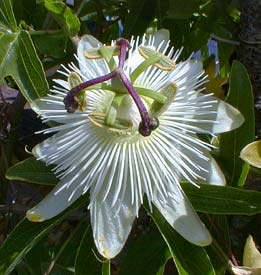 But P. caerulea being root-hardy to ten degrees F., it is at worst a die-back perennial that might even be tried in zone six or seven. It has such a strange flower I figured it was worth a try, & it did turn out to be exceedingly rewarding in the mild micro-climate of Puget Sound. By its very first mid-summer this vine had crept all over the trellis & in its second year it spread far off the trellis clinging by its own tendrils to the wooden fence. By now it needs considerable pruning before each spring or it would start the year already out of hand. It reaches itself into nearby shrubbery, but whenever it goes where it wasn't supposed to, I either prune away or lift any wandering vines to the trellised fence.
But P. caerulea being root-hardy to ten degrees F., it is at worst a die-back perennial that might even be tried in zone six or seven. It has such a strange flower I figured it was worth a try, & it did turn out to be exceedingly rewarding in the mild micro-climate of Puget Sound. By its very first mid-summer this vine had crept all over the trellis & in its second year it spread far off the trellis clinging by its own tendrils to the wooden fence. By now it needs considerable pruning before each spring or it would start the year already out of hand. It reaches itself into nearby shrubbery, but whenever it goes where it wasn't supposed to, I either prune away or lift any wandering vines to the trellised fence.The vines April through autumn are perpetually covered over with buds, & every day more flowers open. The blossoms are bisexed, each having male stamens & female pistil within the purple corolla.
There is considerable variation in this species' behavior one specimen to the next, especially when grown from seed, & cloned strains produced through different nurseries will have differing habits one clone to the next. Ours produce buds with a high percentage that open into complete or near-complete flowers in summer. The percentage of incomplete flowers increases toward autumn, ranging from flowers lacking the purple corollas hence pure white, to buds that have no flower parts inside them at all. Often the sepals remain after the flower is spent, so that the vines seem to have two or even three different kinds of flowers, small yellow-green sepal-flowers, the large famously elaborate white & purple blooms, & partial blooms such as those which are pure whites. A July portrait of one of the all-white flowers is shown second on this page.
The full flower only lasts one or two days, then the sepals reclose creating a wrinkled lantern inside which the fruit begins to develop. Occasionally a flower bud breaks loose of the sepals before opening, & these buds likewise hang like raggedy lanterns with dead parts inside.
These decorative papery lanterns sometimes fall loose without producing fruit, though our vine has been had a great amount of fruit production through most of summer. In 2002 we saw more of the fruitless lanterns, but every year since we've had increasing numbers of the bright orange hen's-egg sized fruits or "maypops."
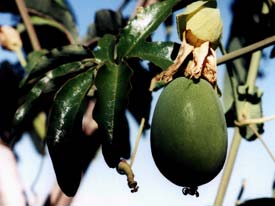
II. Fruits of P. caerulea & Other Species
"Seek thou the passion-flower
Bloom of one twilight hour.
Haste, thou art late!
Its hidden savors wait."
-Ellen Mackay Hutchinson Cortissoz.
d.1933
In our cool weather, I was not expecting to score the large edible fruit of this tropical or subtropical vine. But each year has found us with increasing numbers of fruits appearing earlier & earlier. When the vine was still smallish, after an unusually hot summer in 2002, it bore lots of fruits that were ripening in September & October, though by October the temperature had dropped such that the majority of the fruits remained green. Summer 2003 in turn was record-breaking for heat & dryness, & the passion vines were heavy with fruits, ripening day by day beginning in August. In 2004, ripe fruits were on the vines by July, perpetually flowering & fruiting until October.d.1933
The fruits at first look like limes & are green for the longest while. Then one by one they start turning yellow then orange, while at the same time the vines continue to produce new flowers, just so long as there is not a hard frost.
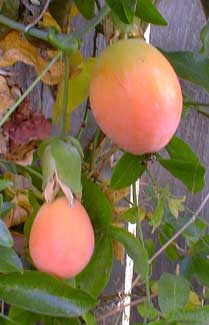 The colorful egg-fruits can be eaten raw fresh from the vines. The soft thick rind is extremely bland if eaten raw & not worth it for texture of flavor, so what I do, about every other day throughout summer, is stand among the vines plucking fruits, popping them open, & eating only the seeds. I love them.
The colorful egg-fruits can be eaten raw fresh from the vines. The soft thick rind is extremely bland if eaten raw & not worth it for texture of flavor, so what I do, about every other day throughout summer, is stand among the vines plucking fruits, popping them open, & eating only the seeds. I love them.The soft bright red seeds of P. caerule, are sweet & mild. In 2002 many of the fruits were partially hollow & only one-third filled with seeds; the percentage of the interior taken up by seeds will vary from plant to plant & species to species. In 2003 the bright red pulpy seeds were much more tightly packed inside the eggs, & in 2004 the red pulp & black seeds filled the maypop "eggs" even more, though ther is always at least a small airpocket remaining.
I find the flavor of the seedy pulp quite pleasant & the seeds do not need to be removed from the pulp. But Granny Artemis finds the flavor boring. I've given them to visitors who pretty much universally don't like them either because the pulp is so seedy so they don't like the texture, or merely because the seedy pulp looks a bit like raw salmon egg fishbait. It surprises me I'm the only one that thinks they're excellent, but not surprised that in regions where people are completely familiar with these fruits, they're as well regarded as I find them to be.
Since I seem to be the only one around here that likes them a lot, I just eat the seeds out of the ripest ones while in the garden, & the rinds go to compost. In order to eat rind & all, including unripe green fruits, they can be prepared fried in butter & spice in an iron skillet with either potatos or eggs added. They can also be fried in olive oil along with onion & sweet bell pepper, basil, & ground black pepper, & will keep in the refrigerator indefinitely as a relish, which tastes super delicious on vegie burgers. Indeed as an oily well-cooked relish in which the passionvine "maypops" are not the dominant ingredient, even Granny Artemis likes them.
The only species of Passiflora whose fruits I have ever seen in our local green grocers are P. quadrangularis (the familiar giant pale yellow Passionfruit), & P. edulis (the roundish handball-sized Purple Passionfruit, which also has a yellow variety). These are the only two species designated Passionfruit per se. Because they are meaty fruits rather than seedy or partially hollow, they have proven to be the main species significance to fruit growers, having many large-scale growers in warm humid locations around the globe. Typically the edible seeds are scooped out & discarded & only the thick pulp on the inner rind is eaten, & consumers don't even consider the fact that the wetter pulp surrounding the seeds is just as sweet & could at least be extracted as juice. By comparison, species with no pulp on the inner rind, but only a mouthful of pulpy seeds, simply do not fit the commercial rquirement.
A third species is in commercial cultivation in Australia, Hawaii, & New Zealand, P. mollissima, which is occasionally imported to the US market though I haven't seen these locally as yet. It is usually called Banana Passionfruit (or Banana Poka), having a whitish yellow rind, pink pulp, & black seeds.
There may be other species with future commercial possibilities, but most would require consumers to appreciate that the thin rinds enclose only sweet moist oily seeds. In their native countries they are appreciated; even our P. caerulea is a common fruitmarket offering in South America, & all of the species are rich in Vitamins B, A, & especially C. In South America, the bright red seeds of P. caerulea are used to make a very pleasant sweet juice drink. P. laurifolia or Jamaica Honeysuckle has especially sweet fruits which are the same golden-orange color, but instead of red seed pulp, it contains juicy yellow seeds. Even the flowers of these two species are quite sweet, & have been used to make syrup.
The fruits of less commercial species, including ours, are never marketed as Passionfruit per se, but have a variety of names of their own. Wherever they grow wild, children pluck these "water lemons," "granadillas," "golden bell apples," "maypops" (so called because they "pop" like a little balloon if you squeeze the fruit), or "sweet cups." Children in particular bite a hole in one end of the soft rind, then suck out the sweet seeds. I do this myself standing in our garden, & it is truly a thrill; very few of the fruits go to waste in our garden even if I am the only one that likes them a great deal.
Passion Flower, with a preference for P. incarnata, is also grown as a medicinal herb, for the leaves, fruit rinds, & seeds contain cyanogenic glycoside. If the fruits are eaten in sufficient quantity before they are ripe, they have a sedating effect believed by many to relieve symptoms of insomnia, anxiety, & stomach upset. A tea can also be made of the leaves for this purpose, from just about any species one has available. It was in great part its medicinal value that caused species of Passiflora to be distributed into Southeast Asia during the era of French colonialism, & now that a handful of species have naturalized in areas of Malayasia, Thailand, Viet Nam & Singapore, extracts & powders & teas are today incorporated into traditional medicines. Species grown for whatever reason (as medicinals, for the fruit, or for garden beauty) have escaped from cultivation to become naturalized, to the detriment of native flora, in Ceylon, India, Hawaii, & many places around the world, though they are not invasive for the Northwest.
A few final asides relating to fruit baring: P. hahnii invariably requires an unrelated clone to pollinate it, & P. murucuja is very curiously induced to self-pollinate but only when an unrelated clone attempts to pollinate it. Nearly all species produce edible fruits, but a couple of rarely gardened varieties are toxic while green, notably P. adenopoda. The seeds in Passiflora fruits are generally viable, but some hybrids are sterile or will only produce the occasional fertile seed amidst many that are sterile, whereas the hybrid P. sapphire produces entirely hollow fruit with no seeds at all. The two species that are most apt to self-pollinate are P. incarnata & our own P. caerulea, but it is never a sure thing.
Seeds of P. caerulea grow easily if planted fresh, pulp & all, & I frequently remove unwanted seedlings. But the seeds do not dry well to plant later. This would not be generally true of all species, as some dry well, others require specialized conditions to germinate, triggered for instance by the stomach acids of birds or fruit bats.
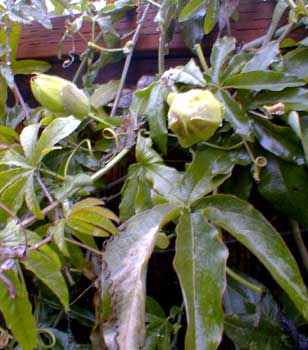 III. Our Continuing Care of P. caerulea
III. Our Continuing Care of P. caerulea
"There has fallen a splendid tear
From the passion-flower at the gate.
She is coming, my dove, my dear;
She is coming, my life, my fate."
Alfred, Lord Tennyson,
1809-1892
Obviously our vine has proven to be self-pollinating, but this capacity varies from plant to plant even within a single species of Passiflora. Despite the bisexual flowers, many vines prefer to cross-pollinate with a neighboring vine. I suppose it's possible or even likely we actually have more than one plant, as there is not a single leader growing from the large rootstock we started with. Pollination is assisted by bees, butterflies, hummingbirds, or wind; & in these vines' native regions, even bats serve as pollinators. 1809-1892
The reason the flowers are so fantastic is because competition for pollinators can get pretty tough in tropical forests with thousands of lovely choices to choose from if you're a pollinating critter. Passion Flowers compete exceedingly well. Their lack of choosiness as regards which pollinator visits them is one very big reason these vines have naturalized in so many places outside their natural range.
P. caerulea, originally native of Brazil & Argentina, can potentially cover a twenty-foot width of a tall fence, though in our zone partial die-back can be expected each winter & even so it'll reliably cover at least a ten-foot stretch of fence. It does best in poor sandy soil; it is sometimes recommended that it be planted in, of all things, crumbled bricks. Plus it almost never needs fertilizer. It would never require nitrogen, & rarely calcium & phosphate. Puget Sound's rich loamy acidic soils definitely excite rapid growth, but can sometimes discourage heavy bloom. It also prefers direct sunlight & droughty conditions. It is almost entirely disease-resistant except that it is susceptible to root rot if it gets too much water.
Virtually everything this vine would regard as ideal we have failed to provide. It didn't have a great deal of direct sun until it reached the top of the fence. It is near a rhododendron bed which gets regular watering, & the best I can do for the vine is keep the soaker hose away from it & never intentionally directly water it. It is stuck in rich soil, though I avoid getting fertilizer around it when feeding other things. It loves heat, but experiences chilly autumns & winters.
In its first spring through autumn in our yard, it grew like mad & was perfectly happy. In winter the vines lost most but not all their leaves; it turns out to be partially evergreen even through our winters. It requires at least an annual pruning even if it doesn't look like it needs it, because it fruits & flowers on new vines. Blooms occur as early as April, but it is blooming most extremely beginning in June, & continues through much of Autumn or whenever a couple of heavy frosts finally cause it to settle down again until spring.
It keeps producing buds & flowers like crazy all summer, never ceasing to bloom right up to October, when new flowers & large ripening fruits decorate the vines side by side. The fruit portraits above are from early September 2002 (green fruit) & late August 2003 (orange), but the same portraits could be snapped at the end of October. Even when the chill stops it from completely flowering, its aborted flowers will continue to be decorative up to November, either as yellow-green papery sepals from which unfinished flowers fell, or as closed lanterns containing pollinated reclosed flowers which winter stopped from becoming fruits, as sown in the last photo from November (2003).
A next page is about the mythology & symbolism
of Passiflora caerulea. As it will potentially offend some,
it has been given a separate
Passion Flower Symbology Page.